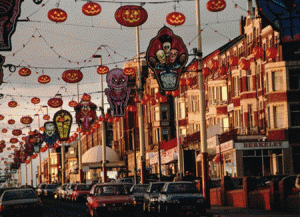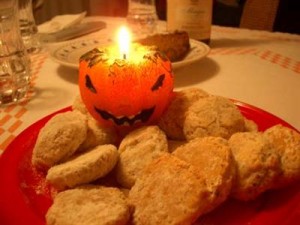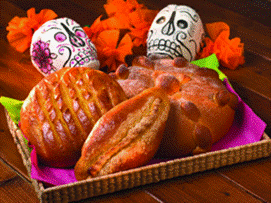關於35個奇妙的聖誕節傳統,我們特別翻譯外國網站的原文供大家參考。
資料來源 https://www.lovehomeswap.com/blog/places-and-spaces/35-bizarrest-christmas-traditions
We know that not everyone celebrates Christmas in the same way. Different countries have their own traditions – and some of them are truly bizarre.
Christmas comes but once a year. We’ve gone away and handpicked the weirdest Christmas traditions from around the word. From deep fried caterpillars to rotting birds, here are the world’s most unusual festive rituals.
我們知道不是所有人都用一樣的方式慶祝聖誕節。不同國家有不同的傳統,而有一些是非常有趣的。
聖誕節是ㄧ年一度,我們特別選了一些來自世界各國奇怪的聖誕傳統。從油炸的毛毛蟲到腐敗的鳥兒,這裡有世界最特殊的慶典儀式。
- South Africa非洲
This festive South African delicacy is not for the faint hearted-on Christmas Day, Locals tuck into the deep-fried caterpillars of the Emperor Moth.
在熱鬧的非洲慶典,沒勇氣的人是優雅不來的- 在聖誕節當天,當地人會大吃油炸的帝王蛾毛毛蟲
- Austria奧地利
Austrian children live in fear of Krampus-a Christmas devil who’s said to beat naughty children with branches.
奧地利兒童都很怕魔鬼Krampus,傳說有個聖誕惡魔會用樹枝抽打調皮的小孩
3.Catalonia加泰隆尼亞
Catalonians include the figure of the Caganer in their nativity scenes- a small figure of a defecating man.
加泰隆尼亞把便便人偶- 也就是一個作勢在排便的人偶,放進耶穌誕生圖裡
4.Catalonians加泰隆人
Catalonians also have the Tió de Nadal, otherwise known as the “pooping log”. Decorated with a face and blanket, on Christmas Eve the log is placed halfway into a fire and beaten with sticks.
加泰隆人還有另一個聖誕人偶,也是一個便便人偶。用臉和圍巾裝飾,在聖誕夜的時候被掛在火中用樹枝抽打。
5.Norway挪威
There’s no cleaning on Christmas Eve in Norway- all brooms are safely hidden away, in case they’re stolen by witches and evil spirits.挪威的聖誕夜是不打掃的,所有的掃把都被藏的好好的,以免被女巫或者惡靈偷走。
6.Japan日本
Advertising can be incredibly powerful. Thanks to a campaign in 1974, many Japanese families eat at KFC on Christmas Eve.
廣告大肆播放。感謝1974年的大選,很多日本家庭在聖誕夜都會吃肯德雞
7.Venezuela委內瑞拉
Venezuelans attend Mass in the run-up to Christmas. However, Caracas residents have developed a strange tradition- journeying to Mass on roller skates.
委內瑞拉人以跑步參加彌撒來迎接聖誕。然而,卡拉卡斯居民發展成一個奇特的傳統,以溜滑輪來參加彌撒。
8.Greenland格林蘭島
Greenland has some unusual Christmas recipes. Matak is raw whale skin, served with blubber. Kiviak is 500 dead auk birds, stuffed into a seal skin, and left to ferment for 7 months.
格林蘭島有一些特殊的聖誕節食譜。馬特卡是一道生鯨肉佐鯨油脂。醃海雀是用500隻死去的海雀,塞進海豹皮,然後放著發酵七個月。
9.Germany德國
Germans hide a pickle in the Christmas tree on Christmas Eve- the first child to discover it in the morning receives a small gift.
德國人在聖誕夜藏一條酸黃瓜在聖誕樹上,第一個在早上找到的小孩就可獲得一份小禮物。
10.New Zealand紐西蘭
Rather than using the traditional conifer, New Zealanders decorate Pōhutukawa trees at Christmas.
有別於使用傳統的針葉樹,紐西蘭人在聖誕節用高鐵心木來裝飾聖誕樹。
11.Portugal葡萄牙
Consoda is a traditional Christmas morning feast in Portugal. This is a time for remembering the dead, and families lay places for the souls of their late loved ones.
Consoda在葡萄牙是一種傳統的聖誕節早宴。這是一個緬懷逝者以及該年過世的家人,希望他們靈魂得到安息。
12.Germany德國
German children leave a shoe outside the house on December 5th, which is then filled with sweets overnight. Naughty children awake to find a tree branch in the shoe instead.
德國的小孩在12月5號當天把一只鞋子留在房子外面,過了一個晚上就會被甜食塞滿。頑皮的小孩就必須在樹枝上找鞋子。
13.Ukraine烏克蘭
Ukrainians forego tinsel and baubles, instead decorating their Christmas trees with an artificial spider and web.
烏克蘭人不用金箔和彩球,他們用人造蜘蛛網來裝飾他們的聖誕樹。
14.Czech Republic捷克
In the Czech Republic, unmarried women stand by a door and throw a shoe over their shoulder- if the toe is pointing towards the door when it lands, they will get married within the next year.
在捷克,還沒結婚的女性會在站在門邊,把鞋子往上拋過肩,假如鞋尖在落下時朝著門,他們就會在隔年之內結婚。
15.Estonia愛沙尼亞
On Christmas Eve, Estonian families traditionally head to the sauna together.
在聖誕夜,愛沙尼亞的家庭傳統會一起去洗蒸氣浴。
16.Wales威爾斯
Mari Lwyd is performed in some Welsh villages on Christmas Eve. A villager is chosen to parade through the streets, bearing the skull of a mare on the end of a stick.
瑪莉格雷在聖誕夜一些威爾斯村莊中表演。會選出一個村民,掛著母馬的頭顱,另一端用樹枝撐著,在街上遊行。
17.Iceland冰島
The Yule Cat is said to stalk the Icelandic hills. Those who don’t receive new clothes before Christmas Eve are said to be devoured by this mythical beast.
傳說有耶誕貓在冰島的山丘出沒。那些沒有在聖誕夜前收到新衣服的人,會被這個神祕的野獸吃掉。
18.Sweden瑞典
Since 1966, authorities in Gävle have installed a straw Swedish Yule Goat. However, almost every other year, vandals have succeeded in burning it down.
從1966年開始,政府當局在耶夫勒用稻草設置一座聖誕羊 (耶夫勒羊)。然而,幾乎每一年,都會被破壞者成功燒毀。
19.Another Swedish tradition involves festive rice pudding. A peeled almond is hidden in the dessert, and the person who finds it will supposedly be married within a year.
另一個瑞典的傳統是和慶典的米布丁有關。一顆去皮的杏仁會被藏在甜點裡,發現的人據說會在一年內結婚。
20.Great Britain大不列顛
An age-old tradition dictates that each member of the family must stir the Christmas pudding mix in a clockwise direction before it’s cooked, making a wish as they do so.
有一個流傳已久的傳統,家庭的每個成員在聖誕節,都要在布丁烹煮前順時針攪拌一下布丁,然後一邊許下願望。
21.Italy義大利
Rather than Snta Claus, Italian children await the arrival of Befana, a friendly witch who delivers sweets and toys on the fifth of January.
義大利小孩不是等聖誕老人,而是等待貝方娜- 一個會發送甜點和玩具的親切女巫,在1月5號的到來。
22.Ethiopia衣索比亞
Ethiopians celebrate Christmas on January 7th. People wear white clothes, and the men play ganna- a fast-paced game with sticks and wooden balls.
衣索比亞人在1月7號這天慶祝聖誕節。人們會穿著白衣服,男生會玩ganna- 一種用木棒和木球節奏快速的遊戲
23.Latvia拉脫維亞
In Latvia, a group of “mummers”, dressed in a variety of costumes, travel from house to house. Each household must give them a treat in return for a blessing.
在拉脫維亞,有一群啞劇演員,穿著各式各樣的戲服,逐門逐戶的拜訪。每一戶都必須給他們一些東西作為祝福。
24.Guatemala瓜地馬拉
Guatemalans sweep out their houses before Christmas. Each neighborhood will then create a large pile of dirt, before placing an effigy of the devil on top, and burning it
瓜地馬拉人在聖誕節前會大掃除。左鄰右舍會將灰塵聚成一堆,再把代表惡魔的肖像放在最上面,然後燒掉
25.Cuba古巴
Every December, Cuban city Remedios plays host to the Parrandans festival. The city divides into two halves, each building a themed sculpture from light bulbs, in preparation for Christmas Eve.
每一年12月,古巴城雷梅迪奧斯會舉辦帕朗達節饗宴。整座城市會區分為兩半,每個建築物用燈泡裝飾成不同的主題雕像,迎接聖誕夜。
26.Bavaria巴伐利亞
In Bavaria, a noisy Christmas tradition has taken hold. Wearing the national costume of lederhosen, Bavarian Highlanders fire mortars into the air.
在巴伐利亞,熱鬧的聖誕節已行之有年。穿著民族服飾的皮短褲,在巴伐利亞高地將迫擊砲射向空中
27.Greece希臘
The Kallikantzaroi, a race of evil goblins, lurk underground according to Greek legend. During the 12 days of Christmas they supposedly surface, wreaking havoc.
小妖精,根據希臘傳說,是潛伏在地底下邪惡精靈的一族。在聖誕節的12天當中,他們可能會露面,帶來浩劫。
28.Slovakia斯洛伐克
In Slovakia, the most senior man of the house takes a spoonful of loksa pudding and throws it at the ceiling- the more that sticks, the better.
在斯洛伐克,一家之中最年長的人會盛一匙洛克薩布丁,然後丟向天花板,黏的越牢表示越好。
29.Japan日本
White Christmas cards are sent to friends and family. Red cards, however, are to be avoided- this is traditionally the color of funeral announcements.
白色聖誕卡會寄送給家人朋友。但是紅色的卡片則是禁忌- 這在傳統上是用來告知喪禮的顏色。
30.Canada加拿大
Canada Post recognizes the address Santa Claus, North Pole, Canada, HOHOHO. Any letters received bearing this address are both opened and replied to.
加拿大郵政承認聖誕老公公的住址,北極-加拿大-HO HO HO。任何接獲此住址寫來的信都會被開啟並回覆。
31.Finland芬蘭
Finnish people traditionally mark Christmas with a touching tribute to the dead. Families light candles at the graves of their departed loved ones, making Finnish graveyards a beautiful sight.
芬蘭人會在聖誕卡上寫下對死者感人的敬詞。家人會在他們逝去親友的墓碑上點上蠟燭,讓芬蘭墓地城為一個漂亮的景緻。
32.Icelan冰島
Icelandic children leave a shoe on their bedroom windowsills during the 12 days of Christmas. Each night, it’s filled with sweets or gifts, ready to be enjoyed in the morning.
冰島小孩在聖誕節的12天期間,把一只鞋子放在臥房窗台。每一晚,都會被塞滿糖果或禮物,一早就能享用。
33.England英格蘭
Santa Claus traditionally leaves presents in a child’s stocking on Christmas Eve. However, naughty children may wake up on Christmas morning to find a lump of coal in their stockings.
聖誕老人傳統上會在聖誕夜把禮物放在孩子們的長襪。但是,頑皮的孩子可能會在聖誕節早上醒來發現,他們的襪子裡被放了一塊煤炭。
34.South Africa南非
South African children are told the story of Danny, a young boy who angered his grandmother by eating the cookies that had been left for Santa. In her range she killed him, and he is said to haunt homes at Christmas
南非的小孩都知道一個Danny的故事,是一個小男孩因為對奶奶生氣,吃了她留給聖誕老人的蛋糕。奶奶居然殺了他,而他的鬼魂據說會在聖誕節出沒在家鄉。
35.USA美國
美國創辦了一個叫做”聖誕老人狂追”暢飲聖誕傳統。每個會場都看見大批人群打扮成聖誕老人,在大型的酒吧裡舉行。
Americans have created a boozy Christmas tradition called The Running of the Santas. Each event sees scores of people- dressed as Santa- taking part in a large bar crawl.



